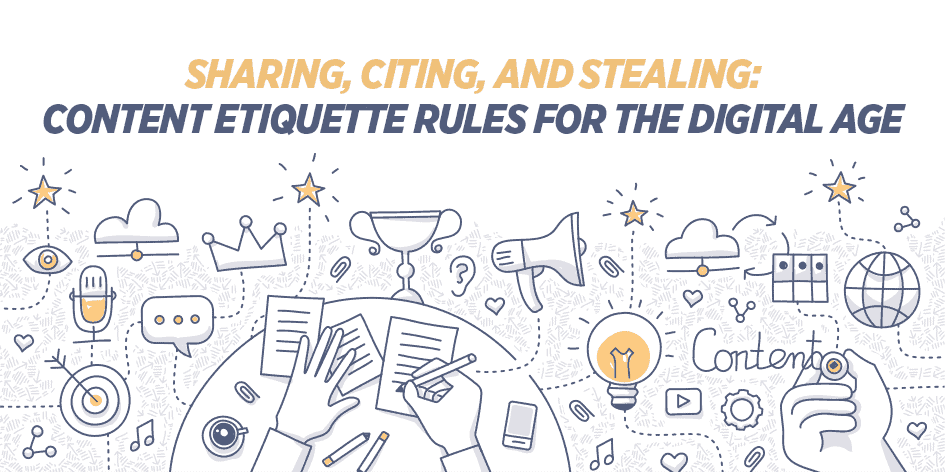The Book of Ecclesiastes and Shakespeare said it long, long ago: “There is no new thing under the sun.”
That was true then, in the days of stone tablets. It was true when Shakespeare was writing his sonnets. And it’s most definitely true now, in the age of the internet.
It seems sometimes that you can Google anything – a dream you had last night, a thought that ran through your head this morning – and find 15 people who’ve not only had that same dream or thought, but written about it to boot.
When you’re writing content for your brand, this can become a little disconcerting. How do you make sure you’re not inadvertently plagiarizing? When and how should you cite sources? What rules govern how you share images or content from other sites?
If you’re new to writing for the web, it’s easy to get paralyzed by all these questions and not write anything at all. To keep that from happening, take a look at these content etiquette guidelines for some of the situations we often find ourselves in when creating or sharing content.
Doing research for a blog post, whitepaper, or other long-form pieces of content
When you’re researching for a blog post, whitepaper, webinar, or other pieces of long-form content, you’ll likely find several sources for the information you’re after.
If you look closely, however, you’ll likely find that many of those sources all found that information somewhere else – from a reputable primary source. That’s as long as the sources you’re looking at are solid, informative ones, not ones intended to be purely entertaining.
The best practice here is to follow those secondary sources back to the primary source, which could be an academic paper, a study, a news article, even a well-researched opinion piece on a popular blog.
Sometimes finding the primary source is very easy, but sometimes it can take some digging. Either way, looking at the primary source yourself will pay off in spades.
For one thing, you’ll know that the data or information quoted is correct.
For another, you’ll be able to ensure that you’re not plagiarizing anyone when you put the info in your own words in your content.
Finally, if you decide to quote, you can quote the original text, rather than someone else’s interpretation of that text.
When you find information or a quote that you want to use, make sure you cite it correctly. At the very least, include a hyperlink to the original page where you found the information, but if you can, it’s best to also include the name of the site or author in your text. That way, readers who don’t click on the link will still know who the information came from.
Direct quotations
Quoting a source on the internet follows the same general rules that you learned in high school English. If you’re taking a direct quotation from somewhere else, you must attribute that quote correctly.
In print, that usually means citing the author’s name, the publication the quote came from, and a date of publication.
On the internet, you want to include the author or publication name, but you can handle the rest of the info by linking to the original source. So you could say something like this:
Corey Wainwright of Hubspot says that when quoting a source online, “Aside from mentioning the person’s name, it’s also nice to provide them with an inbound link – either to the page from which you drew your quote or to another meaningful page on their site.”
Corey’s name is mentioned, the company she writes for is mentioned, and there’s a link to the exact blog post where we found that quote. Now if you want to be extra courteous, as Corey adds in that same post, you can include a link to the person’s Twitter handle (@Corey_bos), Instagram profile or personal website.
When you’re quoting someone else on one of your social media profiles, it’s very easy to do so correctly. You can retweet on Twitter, regram on Instagram, repin on Pinterest and share on Facebook.
If you want to add your own words or context, you can add “via @username” to the Pin, Instagram post, or tweet. If you’re on Facebook, simply type what you want to say in the status bar, add “via the name of the person whose post you’re sharing” and hit “Share.”
You can also link to the person or company’s Facebook page within the text of your Status update by adding “@” to the name.
Using images
We all know that content with images gets far more engagement than content with no images. According to research on visual content marketing by BuzzSumo, blog posts with images once every 75-100 words received twice the number of shares than articles with fewer images than that.
Here’s a graph, also from BuzzSumo, showing that.
In addition, the website’s researchers also found that Facebook posts with images receive 2.3 times more engagement than posts without images.
So images are pretty important in the land of content marketing. However, we’re betting that you don’t have a photographer on call 24/7 to take high-quality photos to use in each and every content asset you create.
That means that you’re going to have to use images that are not “yours” – as in, that you did not create.
The easiest way to ensure that you have the right to use a photo is to pay for it. Sign up for an account with a stock photography website, and you can pay for and download stock images that you can then use in your content. Stock images, by the way, are royalty-free.
There are even some free sites where you can find either copyright-free images or copyrighted images that you can use for free with certain restrictions. Flickr’s Creative Commons is one such site.
See? This is a stock photo we bought from fotolia.
You can also, of course, contact photographers whose work you like and ask if they’ll allow you to use one of their images in a piece of your content (with proper citation, of course).
Some may be willing to let you use the image for free, provided you link back to their website. Others may let you purchase internet rights.
If you are set on using someone else’s copyrighted work for your posts, there’s a set of rules called “Fair Use that you’ll have to follow. Here’s a very brief overview from Nicole Martinez at the Art Law Journal:
“The purpose and character of the use of the photo you’re using should generally not be used for commercial purposes, and will constitute fair use if you’re using the image for purposes of commentary, criticism, reporting, or teaching.”
Now, since most brands have some commercial component, by their very nature, you’re probably safest not relying on Fair Use and sticking to using purchased images. This way, you won’t find yourself in a legal muddle over a photo you thought was fair game.
When in doubt, use a plagiarism checker
If you’re not sure whether what you’ve written is truly original, it’s a good idea to use an online plagiarism checker. There are several of these available, usually for free, and all you have to do is copy and paste your text into a box and hit “check.” You’ll get an alert if the tool has detected plagiarism.
These tools are especially valuable if you’re using freelancers or other contractors to help create your content. You never know when someone may accidentally (one hopes it would never be on purpose) plagiarize a source.
Being courteous and giving credit where credit is due won’t just keep you out of legal hot water. It’s simply the ethical thing to do. For more on creating great content, read our post “What is High-Quality Content?”





